This article needs additional citations for verification .(September 2015) |
This article is about the culture of the Malaysian state of Penang.
This article needs additional citations for verification .(September 2015) |
This article is about the culture of the Malaysian state of Penang.
The Penang State Museum houses artifacts and cultural exhibits. The present building, which was formerly the Penang Free School, is actually half a building, the other half of the building having been destroyed by aerial bombing during World War II.[ citation needed ] A bronze cast of Captain Francis Light, used to stand outside the museum building. It has since returned to Fort Cornwallis where it was first unveiled by the colonial administration. A small museum, it has a fine collection of old photographs, maps and historical records charting the growth of Penang from the days of Francis Light.
The Penang State Art Gallery and the Pinang Gallery showcase the works of local artists. A newer gallery, the USM ABN-Amro Arts and Cultural Centre, located at Beach Street, was established in 2002 to promote art awareness among Penang citizens. The USM ABN-Amro Arts and Cultural Centre closed down in early December 2006 due to lack of patronage. The Universiti Sains Malaysia Museum and Gallery possesses a large ethnographic and performing arts section with a special exhibition on wayang kulit. The art gallery features works by Malaysian artists. Other establishments promoting art awareness include the Alliance française de Penang and Hotel Bellevue.
Penang has a relatively active arts scene. The Penang Philharmonic is a government-supported musical house for Penang Philharmonic Orchestra and the chorus, the Penang Philharmonic Chamber Choir (previously known as Voices of Penang Philharmonic) . [1] The Penang Symphony Orchestra is another amateur orchestra. The Fingerprints Chamber Choir is a leading chamber choir, with members comprising mainly singing teachers and advanced singing students. It has won prizes at several competitions and performs regularly at various festivals and recitals in the country. Other ensembles include the Penang State Chinese Orchestra (a Chinese instrumental orchestra), ProArt Chinese Orchestra, and many other school-based musical groups.[ citation needed ]
The Actors' Studio Greenhall performs stage plays from time to time.
Penang hosts the annual Penang-YTL Arts Festival in December, with theatrical performances, contemporary and traditional dances, art and photography exhibitions, as well as concerts of classical and modern music. The programmes are drawn up by the Penang Arts Council every year and are partly sponsored by the YTL Group of Companies, a corporate patron of the arts scene in Malaysia.
Penang is also home to the indigenous boria, a fading art form with singing and dancing once popular among the local Malay community.
Lion dance is an ancient art form brought from China by early Chinese immigrants, and over time has evolved into a distinctive Malaysian style. The earliest record of lion dancing in Malaysia was the official registration of a Penang lion dance troupe back in 1903 but it is indisputable that the Chinese community had been practising it long before then. The Chinese place special significance to this dazzling form of art, associating it good luck, power, strength, majesty and happiness. Today lion dance remains actively performed especially during Chinese New Year and also during the opening of new businesses.

George Town Festival is a month-long Festival celebrating the Arts, Heritage and Culture in George Town, Penang. Typically held within the month of July since the inauguration of George Town as a UNESCO World Heritage Site on 7 July 2008 together with Melaka, heritage celebrations were held to commemorate this historical event. With the support of the Penang State Government, the Festival grew from a 3-day heritage celebration in July 2009 to become a month long celebration of cultural performances, theatre, opera, music, dance, film, art exhibitions and more in 2011 and 2012. The 2011 George Town Festival featured a host of local talents during the "Tapestry of Culture" themed heritage celebrations, juxtaposed against international acts such as "Vertical Road" by Akram Khan Company. The 2012 George Town Festival received over 78 local and foreign proposals and showcased local talents, particularly in the Opening Event entitled "Silat - Our Heritage for the World", "Live Heritage" - the theme of the 3-day heritage celebrations, Tony Yap Company and Lee Wushu, together with large international acts such as "The Manganiyar Seduction" by Roysten Abel, "Blinded Mind" by Susanna Leinonen Company, The Philippine Madgrigal Singers, Sbaek Thom - Cambodian Shadow Puppets by Cambodia Living Arts, the Tilak Fernando Dance Troupe from Sri Lanka and the Australian Youth Band. The 2013 Festival promises to be bigger and better. [2]
Chingay is a Penang festival which is held every year as part of the Chinese New Year celebrations and also during the birthdays of Chinese Deities. Its history stretched back to 1880. At the turn of the century, Penang became famous for its "Giant Flags Procession". Flag bearers carry and balance giant flag poles (some 10m high) on their shoulders, chins and foreheads then tossing them to the next bearers. Chingay later spread to other states and Singapore.
Penang hosts the annual Penang International Dragon Boat Festival. Established in 1979, this event attracts competitors from as far as the United States, Japan, South Africa and the Netherlands. Dragon boat races can trace their roots back to ancient China and have been going on in Penang waters since 1934. [3] The current festival is held at the Teluk Bahang reservoir.
Pesta Pulau Pinang is a lively and colourful carnival held every year in December. This event were held by Penang State Financial Department under Tapak Pesta and Expo Units and the festivity includes open-air concerts, variety shows, food bazaars, fun fairs, exhibitions, pet shows, a beauty pageant and many more.
Wesak Day is considered as most sacred celebration for the Buddhists as the day commemorates with Lord Buddha's birth, enlightenment and final Nibbana. Wesak Day's night procession is an annual event organised in Penang since 1949 until present days. It was organised entirely by Buddhist community in Penang and funded through donations. The annual grand float procession usually starts at 6.00 pm, from the Malaysian Buddhist Association in Burma Road. The procession floats are beautifully decorated with colourful flowers and bright lights. Buddhist monks will conduct chanting and sprinkling holy water throughout the procession journey.
Thaipusam is an annual religious event celebrated by Hindus to commemorate the victory of Lord Murugan over the demons. It falls on a full moon day on the Tamil tenth month of Thai. Devotees and penitents can be seen bearing kavadis, and piercing their bodies with hooks and spears without seeming to cause any pain or harm as an act of faith and atonement. The centre of the celebration takes place at the Nattukkottai Chettiar Temple Penang at Waterfall Road where the chariot procession ends.
As in other places with a substantial population of Chinese people, Chinese New Year is a grand affair in Penang, celebrated with firecrackers, worshipping at temples, lion dance, sumptuous feasts and open houses. It is also an occasion for family reunions, visiting friends and relatives, and gift exchanges.
Hari Raya Aidilfitri is a Muslim celebration which comes after one month of fasting during Ramadhan. It is a joyous celebration which brings families together and it is the time to seek forgiveness from one another. The Hindu festival Deepavali, also known as the Festival of Lights, celebrates the triumph of good over evil.
The Zhong Yuan Festival (known in Hokkien as Phor Tor (普度)) is celebrated on a grand scale by the Penang Chinese. The Chinese believe that on the 15th day of the seventh lunar month, the gates of underworld would open and the dead souls whom without any descendants to conduct ancestral worship for them would be allowed to roam in the living realm to receive food and offerings. The Chinese would placate the 'hungry ghosts' by organizing big worship celebration that include religious rituals, burning incense, making food offerings and performing Chinese opera or getai on makeshift stages. At the end of the month-long festival, a giant effigy of Da Shi Ye (大士爷) who is maintaining the law and order of the 'hungry ghosts' will be sent off and burned. Throughout the month, it is ill-advised to travel, go out at night or to get marry. This tradition is more popular among Oversea Chinese communities because many Chinese migrants in the past often passed away without any offspring or descendants, therefore they do not have anyone to conduct the ancestral worship for them. Many Oversea Chinese communities will therefore conduct grand seventh lunar month worship celebration as a way to honour those Chinese migrants.
International Artist Goh Lee Kwang born in Penang.
Penang comes alive at night, with many lively night spots such as pubs, bars, bistros, discos, cafes, and even roadside stalls. The most popular places to go to are Upper Penang Road with its many trendy pubs such as Soho Free House, Momo, Fame, Mois, Carmen and Slippery Senoritas; Chulia Street which is awash with many little bars popular with travellers; Pulau Tikus with its Belissa Row and the likes of Orange Bar and Segafredo; and Gurney Drive with its Gurney Walk and Gurney Place. The seaside resort of Batu Ferringhi and Tanjung Bungah also feature many hotel lounges such as Asmara Lounge, The Lounge and Sunset Lounge. Lower-priced eating places like the ubiquitous mamak stalls open until early in the morning, whose signature dishes are roti canai (Indian bread) and teh tarik (milk tea). Also, insatiable Penangites often eat until late at night in places like coffee shops.
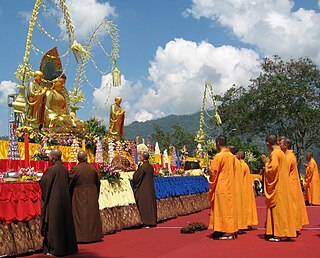
Vesak, also known as Buddha Jayanti, Buddha Purnima, Buddha Day, is a holiday traditionally observed by Buddhists in South Asia and Southeast Asia, as well as Tibet and Mongolia. It is the most important Buddhist festival. The festival commemorates the birth, enlightenment (Nibbāna), and passing (Parinirvāna) of Gautama Buddha in Theravada, Tibetan Buddhism and Navayana.
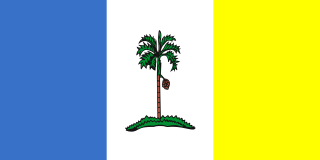
Penang is a Malaysian state located on the northwest coast of Peninsular Malaysia, by the Malacca Strait. It has two parts: Penang Island, where the capital city, George Town, is located, and Seberang Perai on the Malay Peninsula. These two halves are physically connected by the Penang Bridge and the Second Penang Bridge. The state shares borders with Kedah to the north and east, and Perak to the south.

Obon or just Bon is a fusion of the ancient Japanese belief in ancestral spirits and a Japanese Buddhist custom to honor the spirits of one's ancestors. This Buddhist–Confucian custom has evolved into a family reunion holiday during which people return to ancestral family places and visit and clean their ancestors' graves when the spirits of ancestors are supposed to revisit the household altars. It has been celebrated in Japan for more than 500 years and traditionally includes a dance, known as Bon Odori.

Buddhism is the second largest religion in Malaysia, after Islam, with 18.7% of Malaysia's population being Buddhist, although some estimates put that figure at 21.6% when combining estimates of numbers of Buddhists with figures for adherents of Chinese religions which incorporate elements of Buddhism. Buddhism in Malaysia is mainly practised by the ethnic Malaysian Chinese, but there are also Malaysian Siamese, Malaysian Sri Lankans and Burmese in Malaysia that practice Buddhism such as Ananda Krishnan and K. Sri Dhammananda and a sizeable population of Malaysian Indians.
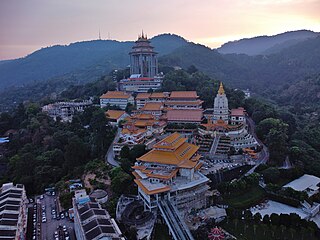
The Kek Lok Si Temple is a Buddhist temple within the city of George Town in the Malaysian state of Penang. Located at Ayer Itam, it is the largest Buddhist temple in Malaysia and an important pilgrimage centre for Buddhists from Hong Kong, the Philippines, Singapore and other parts of Southeast Asia. The entire complex of temples was built over a period from 1890 to 1930, an inspirational initiative of Beow Lean, the abbot. The main draw in the complex is the striking seven-storey Pagoda of the late Thai king Rama VI, which structure is known as the pagoda of Ten Thousand Buddhas with 10,000 alabaster and bronze statues of Buddha, and the 36.57-metre-tall (120 ft) bronze statue of Guanyin, the Goddess of Mercy. The 10.000 Buddhas concept belongs to the Chinese Mahāyāna school of Buddhism while Rama VI was king over a Theravāda country and Buddhist tradition.

The Thean Hou Temple is a six-tiered temple of the Chinese sea goddess Mazu located in Kuala Lumpur, Malaysia. It is located on 1.67 acres (6,758 m2) of land atop Robson Heights on Lorong Bellamy, overlooking Jalan Syed Putra. It was completed in 1987 and officially opened in 1989. The temple was built by Hainanese living in Malaysia and the property belongs to and is run by the Selangor and Federal Territory Hainan Association. It is one of the largest temples in Southeast Asia.

The culture of Malaysia draws on the varied cultures of the different people of Malaysia. The first people to live in the area were indigenous tribes that still remain; they were followed by the Malays, who moved there from mainland Asia in ancient times. Chinese and Indian cultural influences made their mark when trade began with those countries, and increased with immigration to Malaysia. Other cultures that heavily influenced that of Malaysia include Persian, Arabic and British. The many different ethnicities that currently exist in Malaysia have their own unique and distinctive cultural identities, with some crossover.

Buddha's Birthday or "'Buddha Day"' is a primarily Buddhist festival that is celebrated in most of South, Southeast and East Asia, commemorating the birth of the prince Siddhartha Gautama, who became the Gautama Buddha and founded Buddhism. According to Buddhist tradition and archaeologists, Gautama Buddha, c. 563-483 BCE, was born at Lumbini in Nepal. Buddha's mother was Queen Maya Devi, who delivered the Buddha while undertaking a journey to her native home, and his father was King Śuddhodana. The Mayadevi Temple, its gardens, and an Ashoka Pillar dating from 249 BCE mark the Buddha's birth place at Lumbini.
The Chingay Parade is an annual street parade held in Malaysia and Singapore as part of the Chinese New Year festivities, usually in celebration of the birthdays of Chinese deities or in some cases with the procession of the Goddess of Mercy (Guanyin). The name "Chingay" derives from Hokkien, conflating two words: chin-gē (真藝) meaning "true art", and chng-gē (妝藝) meaning "art of costume". PAYM has been an active contributor to Chingay in Singapore. Today, the parade is celebrated by all communities of both Malaysia and Singapore.

Wat Chayamangkalaram, also known as the Chayamangkalaram Buddhist Temple, is a Theravada Buddhist temple within George Town in the Malaysian state of Penang. Situated at Lorong Burma opposite the Dhammikarama Burmese Temple, it is the oldest Siamese temple in the state. Wat Chayamangkalaram becomes a focal point for the annual Songkran, Loy Krathong and Vesak Day festivities within the city.

Brickfields is a neighbourhood located on the western flank of central Kuala Lumpur, Malaysia. It is known as Kuala Lumpur's Little India due to the high percentage of Indian residents and businesses. Brickfields has been ranked third in Airbnb's list of top trending destinations.

Buddhist Maha Vihara is a Sri Lankan temple situated in Brickfields of Kuala Lumpur in Malaysia. The temple became a focal point for the annual Wesak festival within the city suburb.

The architecture of Penang reflects the 171 years of British presence on the island, coalescing with local, Chinese, Indian, Islamic and other elements to create a unique and distinctive brand of architecture. Along with Malacca, Penang is an architectural gem of Malaysia and Southeast Asia. Unlike Singapore, also a Straits Settlement, where many heritage buildings had to make way for modern skyscrapers and high-rise apartments due to rapid development and acute land scarcity, Penang's architectural heritage has enjoyed a better fate. Penang has one of the largest collections of pre-war buildings in Southeast Asia. This is for the most part due to the Rent Control Act which froze house rental prices for decades, making redevelopment unprofitable. With the repeal of this act in 2000 however, property prices skyrocketed and development has begun to encroach upon these buildings, many of which are in a regrettable state of disrepair. The government in recent years has allocated more funding to finance the restoration of a number of derelict heritage buildings, most notably Suffolk House, City Hall and historic buildings in the old commercial district.

The Arulmigu Sri Mahamariamman Temple is a Hindu temple within George Town in the Malaysian state of Penang. The oldest Hindu temple in the state, it was built in 1833, and features sculptures of gods and goddesses over its main entrance and facade.

Malaysian folk religion refers to the animistic and polytheistic beliefs and practices that are still held by many in the Islamic-majority country of Malaysia. Folk religion in Malaysia is practised either openly or covertly depending on the type of rituals performed.
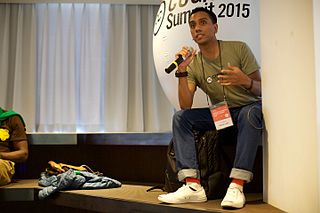
Abdul Muid bin Abdul Latif was a Malaysian-based web designer, graphic designer and digital artist, who is known for promoting the cultural elements of the Southeast Asia from Batik and Songket into his commercial works and artworks.
The George Town Festival is an annual cultural festival held within the city of George Town in Penang, Malaysia.
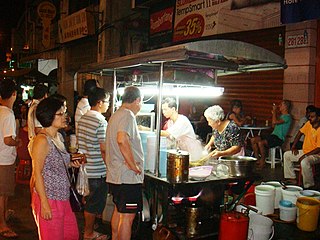
Penangite Chinese are ethnic Chinese Malaysians of full or partial Chinese ancestry who either hail from or live within the State of Penang. As of 2020, 45% of Penang's population belonged to the Chinese ethnic group, making ethnic Chinese the largest ethnic community within the state.

Mahindarama Buddhist Temple is a Theravada Buddhist temple within George Town in the Malaysian state of Penang. The only Sri Lankan temple in the state, it is also one of the select few in Malaysia that houses the relics of the Buddha. The temple becomes a focal point for the annual Vesak Day festivities within the city.